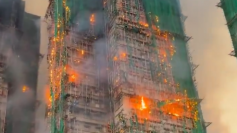China is being touted as a possible customer for the new Mikoyan MiG-41, which, if it enters service, will become the world's first stealth interceptor jet fighter.
The sixth-generation stealth interceptor/heavy fighter designed by Mikoyan reached its development phase last week, announced Rostec Corporation, the state-owned holding company that owns Mikoyan's parent firm, United Aircraft Corporation (UAC).
Ilya Tarasenko, Director General of Mikoyan, said the first production and first flight of the MiG-41 might be completed in 2025. The interceptor is expected to enter service with the Russian Air Force in 2028.
China and India will likely want to cooperate in developing the MiG-41, with both countries becoming customers, later on, claimed Ruslan Pukhov, director of the Center for Analysis of Strategies and Technologies. Pukhov pointed to India's role in helping develop Russia's first stealth fighter, the Sukhoi Su-57. However, India later pulled out of the project, saying it didn't meet its requirements for stealth, combat avionics, radars, and sensors.
The MiG-41 will replace the aging Mikoyan MiG-31 supersonic jet interceptor that entered service with the defunct Soviet Air Defense Force in 1981.
Rostec claims the MiG-41 will have the capability to intercept and destroy incoming hypersonic missiles, and can launch anti-satellite missiles, as well. The MiG-41 will also be able to operate in Arctic conditions.
Russian state media said the MiG-41 is envisioned as an interceptor of U.S. hypersonic missiles. In this role, the MiG-41 will deploy a multifunctional long-range interceptor missile system (MPKR DP) dispensing sub-missiles to increase the chance of intercepting hypersonic glide missiles.
To pursue its speedy prey, the MiG-41 will be capable of a maximum speed of Mach 4.9 (6,100 km/h) and will have a cruising speed of Mach 2.4 (3,000 km/h). It will be able to operate in near-space altitudes with its service ceiling estimated at 45,000 meters (28 miles or 148,000 feet).
However, some Western defense analysts doubt if Russia has the money and resources to develop another sophisticated weapon such as the MiG-41.
Douglas Barrie of the International Institute for Strategic Studies doubts Russia "will be able to develop, manufacture and introduce into service (the jet) in anything like the purported time frame."
He said Russia's aerospace sector is already committed to numerous projects. These include further development of the Su-75, upgrading the Sukhoi Su-34 fighter-bomber/strike fighter, and modernizing the outdated Tu-160 Blackjack, Tu-22M Backfire, and Tu-95 bombers.
"Some would argue that the sector has already more than enough to try to manage without the additional or a project potentially as complex as a new heavy interceptor, or indeed whether there would be realistic levels of funding for a program," said Barrie.






